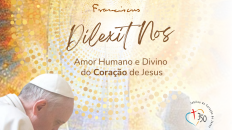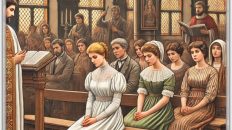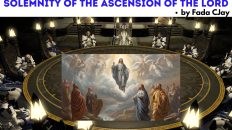INBOX
QUESTION:
QUESTION:
“Hello Bro. Please, enlighten me on
Catholic knighthood. Non-Catholic and even some Catholics believe they are
Secret Cult group only meant to gain powers and to enhance their status in the
society”
Catholic knighthood. Non-Catholic and even some Catholics believe they are
Secret Cult group only meant to gain powers and to enhance their status in the
society”
RESPONSE:
It is so unfortunate that the noble society (the Knighthood) formed in
the Catholic Church has received a negative connotation by many and is often
regarded as a secret society among non-Catholics and even some Catholics.
Before clarifying this erroneous mentality, it is pertinent to state clearly,
the Orders and duties of the Knighthood in the Catholic Church.
the Catholic Church has received a negative connotation by many and is often
regarded as a secret society among non-Catholics and even some Catholics.
Before clarifying this erroneous mentality, it is pertinent to state clearly,
the Orders and duties of the Knighthood in the Catholic Church.
The institution of knighthood has a rich and sacramental root. It stems
from the Holy Orders. It was established in the Medieval era (Middle Ages) in
the Catholic Church. The word order’ (from the Latin ordo) then meant a closed
circle, the members of which were bound by certain obligations and swore to
observe a set of rules. During the crusades, the rules governing monastic
orders were extended to the soldiers who, once in the Holy Land, established
various religious-military orders to ensure the safety of pilgrims and the sick
and to further the battle for Christianity. Some of the most renowned medieval
orders of knighthood were the Templars (1118), the Hospitallers (1113) and the
Order of Teutonic Knights (1198).
from the Holy Orders. It was established in the Medieval era (Middle Ages) in
the Catholic Church. The word order’ (from the Latin ordo) then meant a closed
circle, the members of which were bound by certain obligations and swore to
observe a set of rules. During the crusades, the rules governing monastic
orders were extended to the soldiers who, once in the Holy Land, established
various religious-military orders to ensure the safety of pilgrims and the sick
and to further the battle for Christianity. Some of the most renowned medieval
orders of knighthood were the Templars (1118), the Hospitallers (1113) and the
Order of Teutonic Knights (1198).
ORDERS OF KNIGHTHOOD
Religious (regular) orders of knighthood were brotherhoods that combined
the insignia of knighthood with the privileges of monks, and received this
recognition from both Church and State. Of these the first were purely military
such as the Knights Templars, Orders of Christ, Montesa, Aviz, Calatrava, and
Alcántara.
the insignia of knighthood with the privileges of monks, and received this
recognition from both Church and State. Of these the first were purely military
such as the Knights Templars, Orders of Christ, Montesa, Aviz, Calatrava, and
Alcántara.
Second were military and hospitaler, as the Knights of Malta, Knights of
Rhodes, the Teutonic Order, and the Order of St. James of Compostela. A third
group was purely hospitaler, e.g., Orders of St. Lazarus of Jerusalem, of the
Holy Ghost, and Our Lady of Ransom. Among lesser regular orders, the Knights of
Livonia were the most important.
Rhodes, the Teutonic Order, and the Order of St. James of Compostela. A third
group was purely hospitaler, e.g., Orders of St. Lazarus of Jerusalem, of the
Holy Ghost, and Our Lady of Ransom. Among lesser regular orders, the Knights of
Livonia were the most important.
Secular orders were fraternities of lay knights patterned on the regular
orders of knighthood. In Great Britain they are all now Protestant, including
the Orders of Bath, Garter, and Thistle as well as St. Patrick, St. Michael,
and St. George. In Austria and Spain there is the Order of the Golden Fleece
and in Piedmont the Order of the Annunziata. There are many modern religious or
fraternal organizations whose titles denote knighthood, such as the Knights of
Columbus, Knights of St. John, Knights of the Cross, Knights of Father Mathew,
and Knights of the Blessed Sacrament.
orders of knighthood. In Great Britain they are all now Protestant, including
the Orders of Bath, Garter, and Thistle as well as St. Patrick, St. Michael,
and St. George. In Austria and Spain there is the Order of the Golden Fleece
and in Piedmont the Order of the Annunziata. There are many modern religious or
fraternal organizations whose titles denote knighthood, such as the Knights of
Columbus, Knights of St. John, Knights of the Cross, Knights of Father Mathew,
and Knights of the Blessed Sacrament.
Pontifical knighthoods are honors conferred by the papal court on laymen
who are of irreproachable character, who have promoted the welfare of society,
the Church, and the Holy See. These decorations are bestowed by “motu proprio”
and forwarded by the Secretary of State, or when petitioned by a bishop
expedited through his chancery. The papal orders of knighthood are: 1. Supreme
Order of Christ; 2. Order of Pius IX; 3. Order of St. Gregory the Great; 4.
Order of St. Sylvester; 5. Order of the Golden Militia or Spur; 6. Order of the
Holy Sepulcher. The last may be conferred on clerics and women.
who are of irreproachable character, who have promoted the welfare of society,
the Church, and the Holy See. These decorations are bestowed by “motu proprio”
and forwarded by the Secretary of State, or when petitioned by a bishop
expedited through his chancery. The papal orders of knighthood are: 1. Supreme
Order of Christ; 2. Order of Pius IX; 3. Order of St. Gregory the Great; 4.
Order of St. Sylvester; 5. Order of the Golden Militia or Spur; 6. Order of the
Holy Sepulcher. The last may be conferred on clerics and women.
FUNCTIONS OF THE KNIGHTHOOD TODAY
1. The Heartbeat of the Knighthood is Service: The Knighthood is one of the largest
charitable organizations in the world. Through a variety of fundraisers
throughout the year, the Knights raise financial support for many charities.
The service aspect of the Knights encompasses the Church, Community, Council,
Family, Pro-Life, and Youth.
charitable organizations in the world. Through a variety of fundraisers
throughout the year, the Knights raise financial support for many charities.
The service aspect of the Knights encompasses the Church, Community, Council,
Family, Pro-Life, and Youth.
2. The Knights Supports the Catholic Church: This is because they have been a foundation of support
for the Catholic Church since the middle ages and down to this present day. In
recent years, the Knights of Columbus have performed a variety of projects for
the Universal Church as well as worked with Bishops of the particular churches
in countries where the Knights currently reside.
for the Catholic Church since the middle ages and down to this present day. In
recent years, the Knights of Columbus have performed a variety of projects for
the Universal Church as well as worked with Bishops of the particular churches
in countries where the Knights currently reside.
3. The Knights of Columbus are Pro-Family: Since the traditional family is composed of the husband, wife, and
children, the Knights see them as the core, foundation, and fabric for all of
society. Although the council meetings are for the members, many councils
sponsor activities with the family in mind. It’s a great time to gather
together as Catholic Christians and members of the Mystical Body of Christ.
Realizing that the youth are an integral part of society, the Knights seek to
foster the development of the child from adolescence to adulthood. Asking
for the intercession of the Holy Family is at the center of prayer for the
Knights when it comes to family life.
children, the Knights see them as the core, foundation, and fabric for all of
society. Although the council meetings are for the members, many councils
sponsor activities with the family in mind. It’s a great time to gather
together as Catholic Christians and members of the Mystical Body of Christ.
Realizing that the youth are an integral part of society, the Knights seek to
foster the development of the child from adolescence to adulthood. Asking
for the intercession of the Holy Family is at the center of prayer for the
Knights when it comes to family life.
4. The Knights of Columbus are strongly and
devoutly Pro-Life: Following the teachings of the Catholic Church,
they believe that Life begins at conception and ends in natural death. While
the Knights are in involved in a plethora of activities locally that foster the
Pro-Life movement.
devoutly Pro-Life: Following the teachings of the Catholic Church,
they believe that Life begins at conception and ends in natural death. While
the Knights are in involved in a plethora of activities locally that foster the
Pro-Life movement.
5. The Knights are Faithful to the Catholic
Church: by being
obedient to the teachings of the Church, its Bishops and Priests, and showing
fidelity to the See of Peter. As faithful Catholics, the Knights foster and
develop Vocations to the Priesthood, Religious Life, and Holy Matrimony.
Standing with the Catholic Church, the Knights also fight for Religious
Liberty, which is being threatened across the globe still to this day
Church: by being
obedient to the teachings of the Church, its Bishops and Priests, and showing
fidelity to the See of Peter. As faithful Catholics, the Knights foster and
develop Vocations to the Priesthood, Religious Life, and Holy Matrimony.
Standing with the Catholic Church, the Knights also fight for Religious
Liberty, which is being threatened across the globe still to this day
RESPONDING
TO THE POPULAR MISCONCEPTION
TO THE POPULAR MISCONCEPTION
Having said all these, I tend to respond to the
popular erroneous claim that the kinghood is often associated with the Secret societies.
Having consulted a friend (a Knight in the U.K) “Biose Ifechukwude Joachim”, I
have the following to say:
popular erroneous claim that the kinghood is often associated with the Secret societies.
Having consulted a friend (a Knight in the U.K) “Biose Ifechukwude Joachim”, I
have the following to say:
“The Knighthood is open to all practicing Catholics
who are either married or single (depending on the Order of Knighthood and
their regulations). Hence, single students can become members of the Knight (if
the order permits single Catholics). I am aware that most (if not all orders of
Knighthood) in Nigeria do not admit single persons. However, that is not to say
that single persons cannot become members of certain Knighthood. Interestingly,
some Nigerians have associated the Catholic Knighthood with secret activities. Let
me state here and that it is not implausible that some Knights belong to some
secret societies. That is, it is possible that a member of the catholic Knight
may secretly belong to a secret society and still be a knight. Just as some
Christians profess Christ and go behind the scene to secret cults or gets
involved in pagan worship. Having said this, the catholic Knight has nothing to
do with being a secret society, for it is against its aims and objectives. The problem
lies on the individual knight who may misbehave. In cases like this, we would
not be surprised to see the presence of secret cults at such individuals’
burial rites.
who are either married or single (depending on the Order of Knighthood and
their regulations). Hence, single students can become members of the Knight (if
the order permits single Catholics). I am aware that most (if not all orders of
Knighthood) in Nigeria do not admit single persons. However, that is not to say
that single persons cannot become members of certain Knighthood. Interestingly,
some Nigerians have associated the Catholic Knighthood with secret activities. Let
me state here and that it is not implausible that some Knights belong to some
secret societies. That is, it is possible that a member of the catholic Knight
may secretly belong to a secret society and still be a knight. Just as some
Christians profess Christ and go behind the scene to secret cults or gets
involved in pagan worship. Having said this, the catholic Knight has nothing to
do with being a secret society, for it is against its aims and objectives. The problem
lies on the individual knight who may misbehave. In cases like this, we would
not be surprised to see the presence of secret cults at such individuals’
burial rites.
Some orders of Knighthood carry out security and
background checks to ascertain that potential members are free from activities
that are in conflict with their Christian faith.
The Catholic Knighthood is free from secret activities and is open to all Catholic.
background checks to ascertain that potential members are free from activities
that are in conflict with their Christian faith.
The Catholic Knighthood is free from secret activities and is open to all Catholic.




